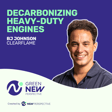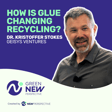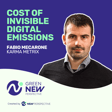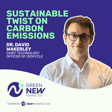
Compressed Air Storage: Renewable Energy's Ally
We are joined by Matthew Ciardiello, the CEO and co-founder of TerraStor Energy Corporation, a company working in the field of compressed air energy storage (CAES).
Matthew discusses the company's work in developing compressed air energy storage, a technology that provides large-scale energy storage for renewable energy sources.
He also speaks about the challenges and opportunities in the field, his vision for TerraStore, and offers advice for those interested in entering the clean tech sector.
We are excited to delve into the current challenges and opportunities in the energy market that TerraStor is addressing.
🕑 KEY MOMENTS
==================
➜ [00:01:14] The Introduction of Terrastor
➜ [00:03:33] Compressed Air Energy Storage (CAES) Explained
➜ [00:05:46] Inspiration behind Terrastor
➜ [00:11:35] Longer duration storage needs for renewables
➜ [00:11:59] Obstacles and roadblocks in compressed air storage
➜ [00:14:40] Financing challenges for large-scale projects
➜ [00:22:59] Closing Remarks
📚 RESOURCES & LINKS
========================
- Website: https://www.terrastor.co/
- LinkedIn: https://www.linkedin.com/company/terrastor/
- 👉 Interview with Matthew Ciardiello: http://bit.ly/3LMmVN5
💡 EPISODE DISCUSSION POINTS
===========================
➜ The role and importance of compressed air energy storage in supporting renewable energy sources.
➜ The challenges and roadblocks in implementing this technology, especially in terms of finding suitable geology.
➜ The role of government policies and regulations in promoting renewable energy storage.
➜ The future developments and growth plans for TerraStore.
➜ Advice for individuals interested in pursuing a career in clean tech.
🌍 SUSTAINABILITY PODCAST CREATED BY NEW PERSPECTIVE
========================
This podcast is proudly sponsored by New Perspective Marketing, a dynamic growth marketing agency in Boston, MA, celebrating 20 years in business. We help sustainably focused B2B organizations grow their brands and scale up revenue. If you or your organization is looking to grow, visit npws.com for more info.
🎧 SUBSCRIBE TO OUR PODCAST
===========================
- Spotify: https://bit.ly/3PSWIyI
- Apple Podcasts: https://bit.ly/3RvlHte
- Youtube: https://bit.ly/3RDzkXg
- Google Podcasts: http://bit.ly/465gjS5
- Deezer: https://bit.ly/3PvQaof
- Amazon Music: https://bit.ly/3PQlijS
- Zencastr: https://bit.ly/48xt75s
💬 FOLLOW US ON SOCIAL MEDIA
============================
- Instagram: https://www.instagram.com/greennewperspective/
- Twitter: https://twitter.com/gnperspective
- Facebook: https://www.facebook.com/greennewperspective
- LinkedIn: https://www.linkedin.com/showcase/greennewperspective/
- TikTok: https://www.tiktok.com/@greennewperspective
- Threads: https://www.threads.net/@greennewperspective
#sustainabilitypodcast #cleanenergy #greennewperspective #sustainability #cleanenergy #podcast #cleantech



















